Off Book
Stacey Mason
PBS’s OffBook series brings several of the most respected names in gaming together for a look at how video games have made the transition to art through mechanical and narrative engagement.
PBS’s OffBook series brings several of the most respected names in gaming together for a look at how video games have made the transition to art through mechanical and narrative engagement.

Mark Wernham packs the fragments of a novel in progress into Machine #69, a "‘fractured digital experience’ that "half-tells the story of a time-travelling salesman who is trying to save the world in the 1960s.” The voice acting is superb, and the script is cleanly written though it sometimes verges on beat parody.
It was early. The diner was serving breakfast. The diner served breakfast all day, and most of the night. Jefferson pushed the glass swing door open and sat down on the banquette nearest the solitary waitress. He made sure he caught her eye.
The navigational scheme – a collection of icons linked to story fragments, arranged in what seems to me to be an arbitrary pattern – is not entirely convincing. It provides access and agency, but there’s not much sense of structure or intentionality. New media skeptics always fear that their leg is being pulled, and the arbitrary interface might reinforce their anxiety.
Machine #69 recalls Ryman’s 253, and especially Bob Arellano’s Sunshine ’69 both in its embrace of arbitrary connection and its fond nostalgia for the era when cheap booze, good drugs, fast cars and hot guns seemed to offer everything worth wanting and when nothing was worth wanting very much.
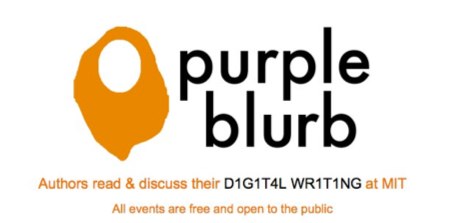
Last night’s Purple Blurb event featured Russian video poet Natalia Fedorova, who gave a short lecture on the historical influences and motivations of Russian digital poetry before showing several video pieces. Her work has strong roots in futurist poetry, as well as other modern traditions of collage and montage. Music was heavily featured in most of the pieces, as was the remixing and repurposing of video clips.
The evening capped off with a promising Q&A session that fell just short of interesting debate. One question observed that avant-garde cinema had clearly been an important influence on “video poetry” and asked what, if anything, distinguished the two. Rather than the given answer (which spoke to the institutionalization of the form in shaping the nomenclature), the question evokes a deeper argument on why these digital works are considered “poetry,” with interesting implications on how we make such distinctions in ever-converging media. Most of the works featured had a particular emphasis on text or spoken language. There was also a clear focus on speech pattern and rhythm in relation to music, though in most cases the two were intentionally asynchronous. Such work forces us to rethink media as a spectrum rather than discrete forms.
Another questioner observed that much of the repurposed video shown in the work had come from diverse cinematic traditions. What significance does this suggest for video poetry as a whole? I think this also returns to the convergence of media. While it’s important to recognize the historical significance of such traditions, we must also keep in mind that in combining media, all the aspects that make up a work come from different traditions. This does not mean we can’t still talk about the work as a combined whole.
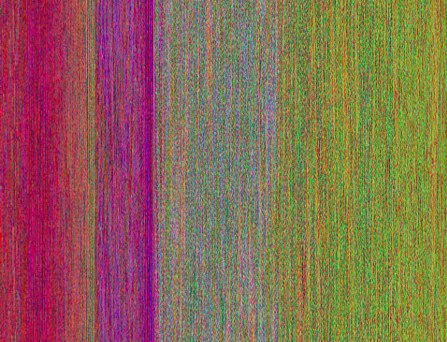
In response to yesterday’s post on databending, someone asked me, “Aren’t you just creating noisy files?” Perhaps. But as Cage would argue, there’s beauty in the noise, and that’s precisely the appeal.
When you open an image in a text editor, the editor will display the raw data of the image file, usually using ASCII or UTF characters. Each character of the code stands for a series of binary inputs that allows the computer to read and display the image file, but to the average user, it’s gobbledygook.
Much of the experimentation I’ve been doing with databending attempts to replace the illegible code with words that we understand. The computer is still not reading the words for any meaning (like a programming language) but rather as a string of characters with each character providing instructions, just as it would with the symbols we replaced.
Sure, there is a case here for phantom signifiers, and the separation of signifier from signified; the computer and I are not “communicating” despite using the same signifiers, but I’m not interested in that. Other generative forms are already exploring the separation of word and meaning and the beauty of typeface as visual art. Those ideals might factor in, but my focus is instead on finding connections, not dissociations. What are the connections between the original image, and the words I’ve placed into the code? Is the code more interesting because of it? Have I removed something from the code and to what significance? Finally, how do the mood and aesthetics of the new image fit with the mood and aesthetics I’ve imparted into the code?
The process of (re)placement is what gives the work meaning.
The image avove is interesting for it’s color and texture. It’s more interesting when you see the original, and even more interesting when you know that I came to the glitched version by replacing symbols $,¢,®, and © with lines from Elliot: “THIS IS THE WAY” “THE WORLD ENDS” “NOT WITH A BANG” “BUT A WHIMPER” respectively. The glitched image is merely an artifact for the real meaning, which is the act of deliberately chosen character replacement.
Is the code noisy? Yes. But we now have a work that we can judge against some of the critical practices of poetry. We have language emerging from noise: repetitive, chaotic, and beautiful. We have not ignored the words’ signified meaning, but rather used those connotations to enrich the process.
Eastgate Systems announces Dangerous Readings, a popup unconference of artists, computer scientists, and researchers coming together to explore new frontiers in narrative.
The event will be November 19-20 in Boston.
This looks to be a great event, with lots of the field’s top writers and scholars on hand. The cast is growing. Registration ($45) is available on the event webpage.

A few weeks ago, I came across an article about a group of programmers who were trying to create music through very small programs. The article recalled Nick Montfort’s poems, generated from a single line of code, but in reading it, I ended up revisiting glitch art and the creative possibilities inherent in code itself.
Thus began an ongoing fascination.
Databending is a form of glitch art in which the artist intentionally corrupts the code of an image file to create art, either by altering the raw data in an editor, or by opening a file in a non-compatible program that will alter the file’s data as it tries to read it. Though the output from such processes is, itself, an artistic object, the aesthetics of databending seem to overlap remix aesthetics and those of electronic literature. A work may be beautiful on first view, but the value of the work grows somehow upon seeing both the source material and understanding the process that the piece underwent.
Databending also has the potential to foreground the aesthetics of the source code itself, an ideal for which many eLit researchers have often argued. Files can be glitched by the injection of creative text, like poetry or prose, into the image’s raw data. This insertion creates a cognitive bridge for the viewer between the largely illegible machine language—which serves as a transitional step between what the machine understands and the higher-level languages with which modern programmers work—and our native language and the critical practices we apply to it. We create a new image and a poetic source code rich with repetition, rhythm, allusion, and other rhetorical devices.
Diane Greco posts some fine advice for new writers from Ira Glass:
What nobody tells people who are beginners — and I really wish someone had told this to me . . . is that all of us who do creative work, we get into it because we have good taste. But there is this gap. For the first couple years you make stuff, and it’s just not that good. It’s trying to be good, it has potential, but it’s not. But your taste, the thing that got you into the game, is still killer. And your taste is why your work disappoints you. A lot of people never get past this phase. They quit. Most people I know who do interesting, creative work went through years of this. We know our work doesn’t have this special thing that we want it to have. We all go through this. And if you are just starting out or you are still in this phase, you gotta know it’s normal and the most important thing you can do is do a lot of work.
A dispute recently broke out over Lori Emerson’s MLA panel abstract for Reading And Writing Interfaces: E-Literature’s Past & Present. Mark Bernstein responded to Emerson calling Loss Pequeño Glazier’s Digital Poetics (2001) the “first book on electronic literature:”
This overlooks Jay David Bolter’s Writing Machines, George P. Landow’s Hypertext, Michael Joyce’s Of Two Minds, Silvio Gaggi’s From Text To Hypertext, Jane Yellowlees Douglas’s The End of Books, and I shudder to think what I’m forgetting.
Of course books on computer-mediated literary works – especially those on hypertext – existed before Loss Glazier’s Digital Poetics. However, what did not exist until the founding of the Electronic Literature Organization in 1999 (thanks to Scott Rettberg, Robert Coover, and Jeff Ballowe) is a name, a concept, even a brand with which a remarkably diverse range of digital writing practices could identify: electronic literature. Moreover, it’s not simply that writers had something by which to bind them together and identify with but it’s also that increasingly e-literature became known as something of a coherent field with a wide, yet still bounded spectrum of means by which critics, teachers, students, scholars could talk about their work. In other words, e-literature became something much more than just hypertext, as valuable as that particular mode of writing may be.
Emerson is probably right that the branding of the “electronic literature” field widened the scope from the perceived limitation of “hypertext” and made it more attractive to digital poets, animators, and game developers.
However, I don’t believe anyone would argue that hypertext literature doesn’t at least fall under the umbrella of “electronic literature” even if she doesn’t believe it serves as a synonym. To defend that Digital Poetics—as influential as it was—as the first book on electronic literature implies that either (1) hypertext literature isn’t eLit or (2) eLit didn’t exist before we bequeathed it with that particular name and brand.
In response to this criticism, Emerson added some comments on institutionalization:
That said, I do think there’s a lively discussion to be had about the potential drawbacks to institutionalization – about how e-literature is in in the unusual position of coming into being at the exact moment that critics, all of whom are contemporaneous to the writers themselves, are attempting to define and delineate the field. There must be something to the fact that we, critics, may be over-determining the field at the same time as we’re helping to support and give shape to it.
A lively discussion indeed; not only does this institutionalization make the field more intensely political and personal than it already was, it shapes the scope of research and creative endeavors to fit within this political framework. In this environment we, as a community, must be vigilant in making sure that history is recorded correctly and that politics don’t overshadow the work.
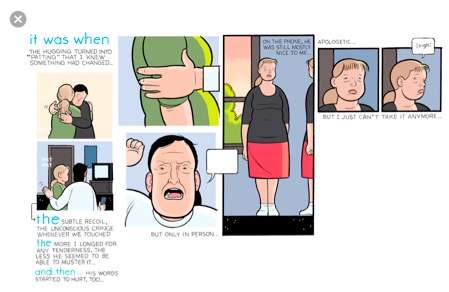
Touch Sensitive is a digital comic by Chris Ware, published as an in-app purchase for iOS by McSweeney’s. The comic explores the nature of touch, and how the act of touching changes in meaning and importance in our relationships.
A name like “Touch Sensitive” on a platform that requires tactile interaction piqued my interest, and I probably would have liked it more if it hadn’t been described to me as an “interactive comic.” Only a few of the panels respond to user input, and never in a way that affects either the narrative or the reader’s understanding or emotional experience.
That said, digital comics are now able to utilize time and space metaphors in new and interesting ways. Touch Sensitive had some nice transitions between panels, reminiscent of panning shots in film. However, because the reader is expecting the space-as-time metaphor that paces comic strips, the animations between panels served as interesting transitions between both space and time. One could easily see how panning and zooming animations might also signal changes in perspective or allow for sight gags and other shifts in the reader’s consciousness.

Kathryn Schulz in The New York Times Book Review takes a look at Paul La Farge’s new hypertext Luminous Airplanes.
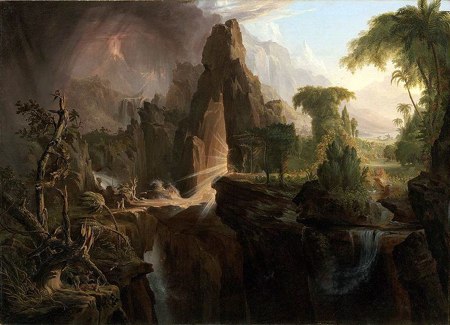
Thomas Cole, Expulsion from The Garden of Eden (detail)
While Lori Emerson and friends explore eLit’s past and present, Talan Memmott and David Prater ask several prominent scholars whether eLit has a future.
The answers are not always as interesting as the questions, but some form a starting point for discussion. John Cayley emphasizes the role of language in “literature,” a highly defensible idea which seems to be in direct opposition to Hayles’ rejection of words as being essential to her idea of “the literary.” The easy way out of this problem might be a revised idea of what “language” is, such as the postmodernist’s idea of language as an empty vessel for projected and perceived meaning, but it would be an interesting debate nonetheless.
I would additionally love to ask the same (or a similar) group of scholars if there has indeed been a Great Fall in hypertext literature, or if it has simply changed forms. How do they feel economics factors into the present and future of the form.
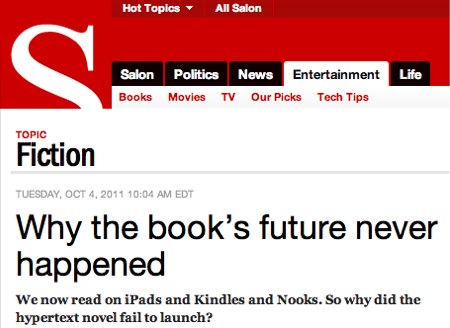
Writing in Salon, Paul La Farge argues that the future of the novel lies in hypertext – and that we’ve been doing it all wrong. He thinks that the early hypertext writers (with the exceptions of Shelley Jackson and Geoff Ryman) “just weren’t good enough writers to carry off such a difficult form.”
But I believe that the promise of hypertext fiction is worth pursuing, even now, or maybe especially now. On the one hand, e-books are beginning to offer writers technical possibilities that, being human, we’re going to be unable to resist. On the other, the form fits with life now..... Just as the novel taught us how to be individuals, 300 years ago, by giving us a space in which to be alone, but not too alone — a space in which to be alone with a book — so hypertext fiction may let us try on new, non-linear identities, without dissolving us entirely into the web.
La Farge’s own hypertext is Luminous Airplanes. It begins with a menu – help | about | begin – that recalls the opening of afternoon and its famous question, “Do you want to hear about it?” The response to “help” has a familiar ring:
My god, you think you need help? You’re not the one sitting in his room in New Haven, Connecticut, right now, wondering what the hell happened to your life.
Looks like an interesting, if sparsely-linked, hypertext,
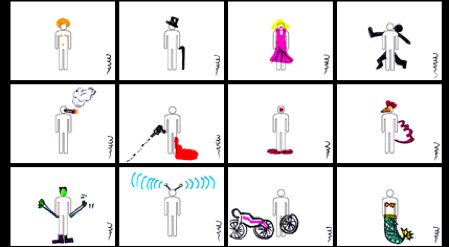
Detail from Jahn Maeda, Human 2.0, 2007
How is technology changing art? Rhode Island School of Design president John Maeda answers:
I think that computers and the advancedness of computers hasn't changed art very much. It's enabled more to happen. Again, that counts a bit more. Better resolution, longer lengths, more color variety, but all in all it's the same thing. It's what experience can I deliver to you that is provocative, that can change how you think. How can I, the art piece, change your relationship -- not to me, but to something else or to the world? That question has nothing to do with technology at all.

photo: Beverly Shank
My quest for coffee this morning brought me to my local library cafe, where I noticed that the teen section was covered in caution tape. The library was not a crime scene, but recognized certain controversial titles for National Banned Books Week.
The American Library Association (ALA) sponsors Banned Books Week each September, an observance that started in 1982. Banned Books Week celebrates the freedom to choose or the freedom to express one’s opinion even if that opinion might be considered unorthodox or unpopular.
This observance stresses the importance of ensuring the availability of those unorthodox or unpopular viewpoints to all who wish to read.